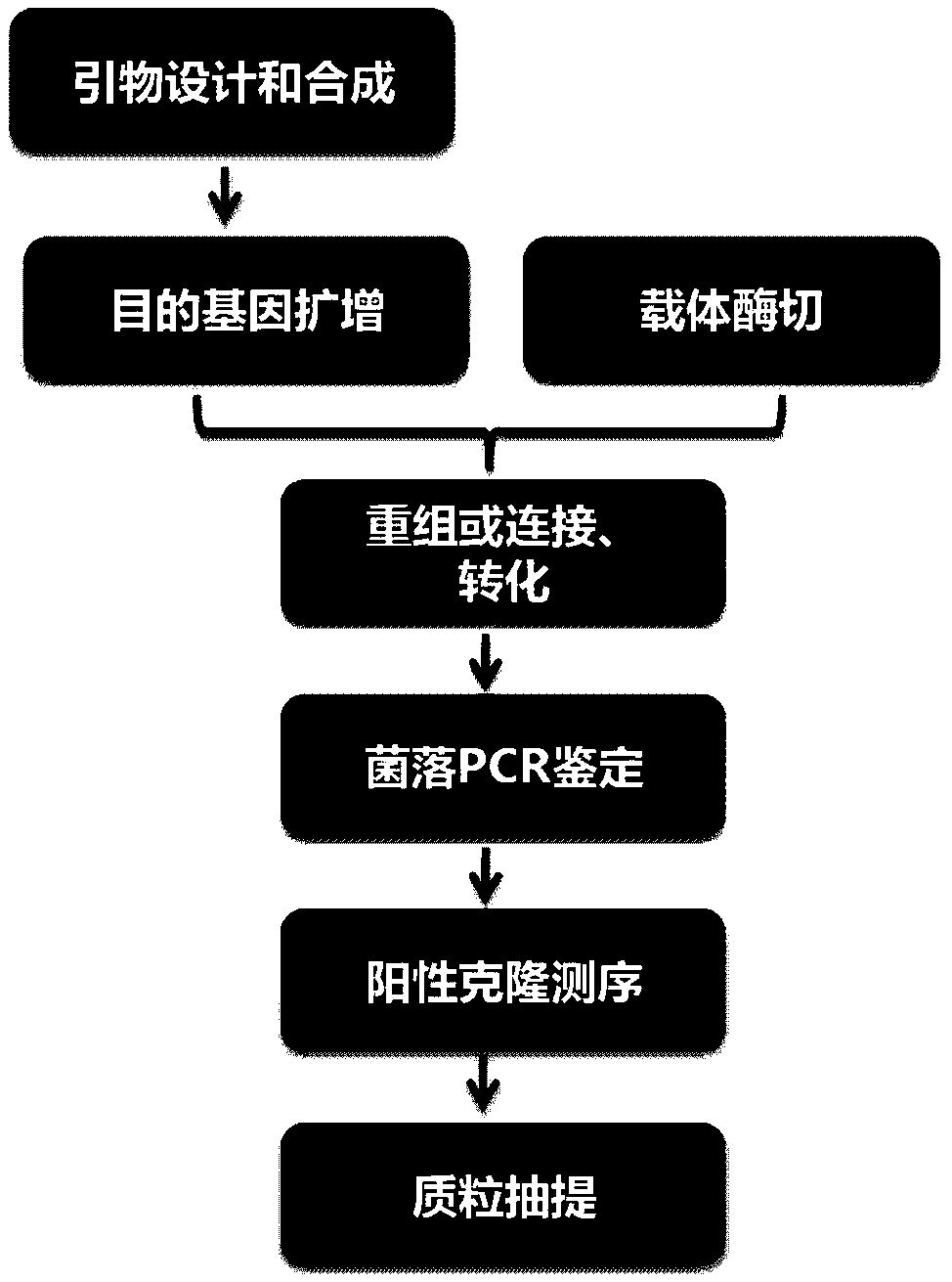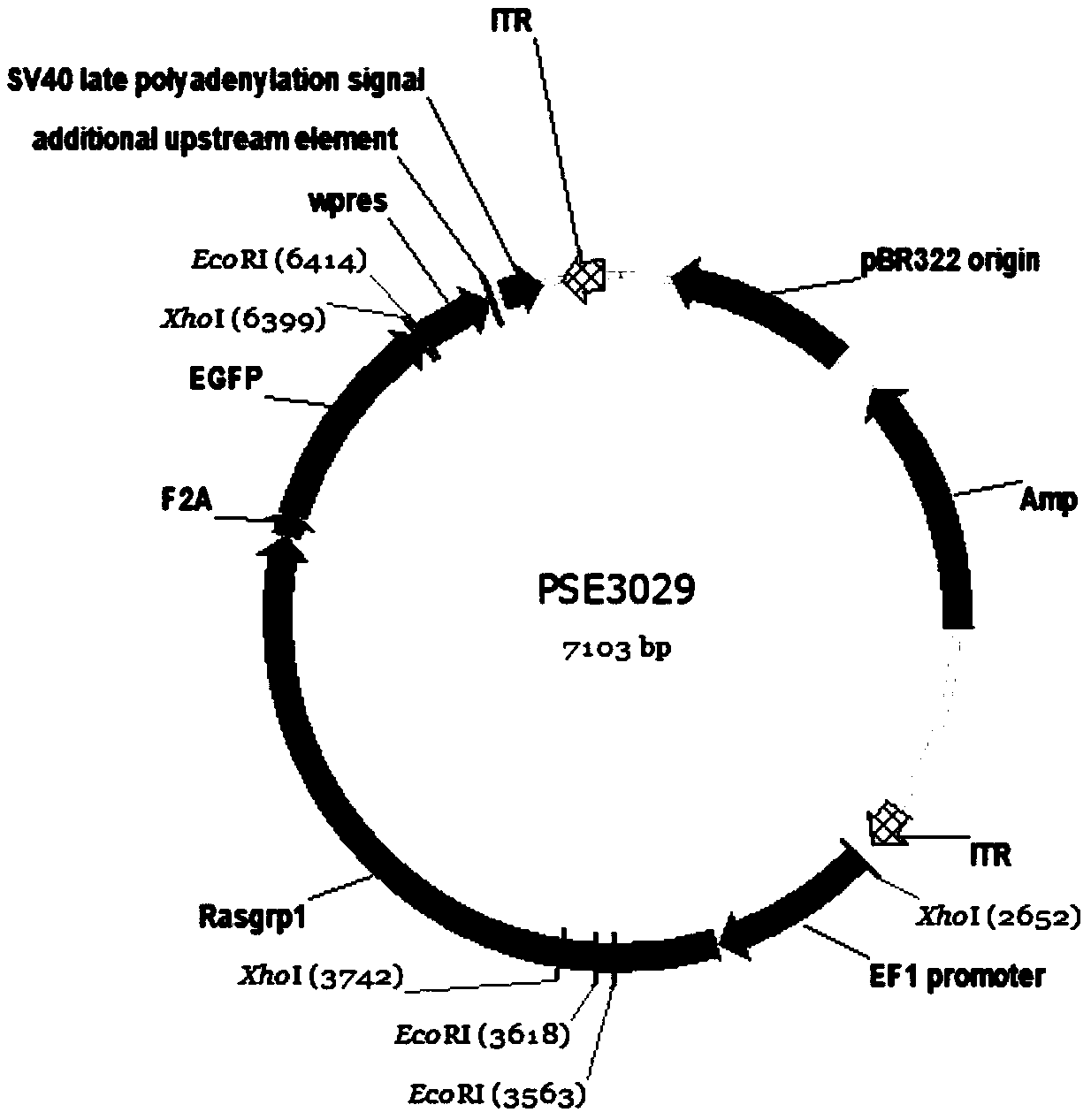Adeno-associated virus for silencing expression of Ras guanyl nucleotide releasing protein 1 (RASGRP1) in intestinal tract of mice as well as preparation method and application of adeno-associated virus
A virus and mouse technology, which is used in the field of adeno-associated virus that silences the expression of RASGRP1 in the intestinal tract of mice and its preparation
- Summary
- Abstract
- Description
- Claims
- Application Information
AI Technical Summary
Problems solved by technology
Method used
Image
Examples
Embodiment 1
[0047] Example 1 RasGRP1 overexpression plasmid construction
[0048] 1. Experimental process
[0049] PCR amplification of the target gene. After digestion of the expression vector, the vector fragment was recovered by gel. Transform E.coli competent cells after homologous recombination between the target gene and the vector fragment. Transformants were identified by colony PCR, and positive clones were sent for sequencing. The clones with correct sequencing were subjected to plasmid extraction. The experimental process is as follows figure 1 shown.
[0050] 2. Experimental materials
[0051] Reagent name
Reagent source
cat. No.
tool carrier
Sangon Bioengineering (Shanghai) Co., Ltd.
/
PrimeSTAR
Takara
DR010A
Taq enzymes and dNTPs
Takara
DR001B
Seamless Cloning Kit
Sangon Bioengineering (Shanghai) Co., Ltd.
/
NheI-HF
NEB
R3131L
HindIII-HF
NEB
R3104L
DH5a Compe...
Embodiment 2
[0097] Example 2RasGRP1shRNA interference vector construction (3 targets)
[0098] 1. Experimental process
[0099] PCR amplification of the target gene. After digestion of the expression vector, the vector fragment was recovered by gel. Transform E.coli competent cells after homologous recombination between the target gene and the vector fragment. Transformants were identified by colony PCR, and positive clones were sent for sequencing. The clones with correct sequencing were subjected to plasmid extraction.
[0100] 2. Experimental materials
[0101]
[0102]
[0103] 3. Vector map
[0104] Carrier map such as Figure 8 shown.
[0105] 4. Digestion of vector
[0106] The tool vector was digested with BspEI and NheI-HF, and the 5719bp vector fragment was recovered. The restriction map is as follows: Figure 9 shown.
[0107] 5.siRNA design
[0108] Viral vector construction framework:
[0109] No.
5’
STEMP
Loop
STEMP
3’
pAAV...
Embodiment 3
[0145] Example 3 Co-transfection of 293T cells with overexpression and interference plasmids
[0146] (1) One day before transfection, the cells were plated on a well plate.
[0147] (2) Cells can be transfected 12 hours after plating.
[0148] (3) After 12 hours of cell plating, prepare the corresponding plasmid / Lipo2000.
[0149] (4) The plasmid (1ug for overexpression, 3ug for interference and interference control) was mixed with 250ul of OPTI-MEM and incubated for 5min.
[0150] (5) While performing 4, mix 10ul of Lipo2000 and 250ul of OPTI-MEM and incubate for 5min.
[0151] (6) After five minutes, mix the two well-mixed solutions together and incubate for 15 minutes.
[0152] (7) While incubating, suck out the original culture medium in the plate laid out yesterday, and add 1ml of OPTI-MEM.
[0153] (8) After the incubation is completed, add solution 6 into the well plate and shake gently.
[0154] (9) Place the orifice plate in a 37 degree incubator for cultivation...
PUM
 Login to View More
Login to View More Abstract
Description
Claims
Application Information
 Login to View More
Login to View More - R&D
- Intellectual Property
- Life Sciences
- Materials
- Tech Scout
- Unparalleled Data Quality
- Higher Quality Content
- 60% Fewer Hallucinations
Browse by: Latest US Patents, China's latest patents, Technical Efficacy Thesaurus, Application Domain, Technology Topic, Popular Technical Reports.
© 2025 PatSnap. All rights reserved.Legal|Privacy policy|Modern Slavery Act Transparency Statement|Sitemap|About US| Contact US: help@patsnap.com



